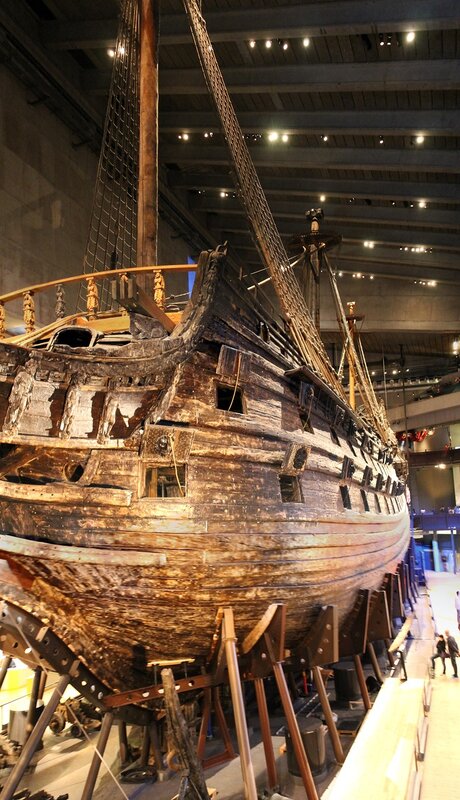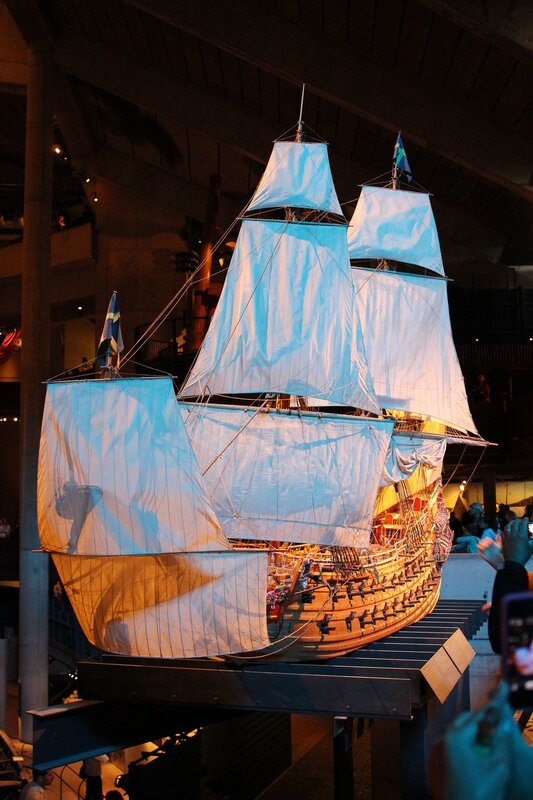Stockholm, Museum of the Vasa ship
Museum of the "Vasa" ship (Vasamuseet map) is a major landmark in the Swedish capital. "If you were here - have you seen Stockholm" so say the guidebooks.

The Exposition is the world's only surviving sailing ship in the early seventeenth century and tells a very instructive story about its creation and destruction.

on 16 January 1625, Sweden's king Gustav II Adolf signed a contract with the famous Dutch ship with master Henrik Hybertsson to build a new warship, which was to become the flagship of the Swedish Royal Navy, the largest and most powerful ship in the Baltic. Immediately began the procurement of materials for construction was harvested more than a thousand tree trunks, which were cut down 16 acres of woodland.

Laying of the ship took place in the spring of 1626 to the Royal military shipyard Blasieholmen in Stockholm. The upcoming flagship has employed more than 400 workers. Workshops foundry started casting bronze cannons. The king took an active part in designing and building a boat, he personally gave instructions to the largest main dimensions and armament.


Shipbuilder Henrik Hybertsson died before the completion of construction, in early 1627 . Prodoljat to work on the "Vase" was entrusted to the master of the shipyard Blasieholmen Hein Jakobsson, and in the fall the ship was launched. The construction lasted until the beginning of next year and 16 January 1628 king Gustav II Adolf visited the shipyard, inspected the ship and was quite satisfied with what he saw. By the summer of 1628 "Vase" was towed to Stockholm and dropped anchor at the Royal Palace.




in the Summer of 1628 "Vase" took on Board the ballast, then began the installation of the guns.

In mid-summer began preparations for the first voyage - loading of ammunition and provisions. On Sunday 10 August was appointed the first output of the ship at sea. The weather was clear, the wind was light but gusty. The ship had to go from downtown to the naval base Alvsnabben to the South-West of Stockholm, where he planned a Grand celebration on the occasion of introducing the new flagship of the fleet. The celebrations were allowed to participate and the families of the crew members, so aboard were many women and children.
to Look at departure on the quays assembled crowd of citizens. The operation took a lot of time — the wind was blowing from the South-West, so the first few hundred meters the ship had to pull with the help of anchors. When the ship was launched into open space, the captain of the ship Sering Hansson ordered to hoist the sails, then steer volley was a salute and "VAZ" went on her maiden voyage.
When the ship came out into the open Bay, a strong gust of wind filled the sails, and the Vasa began to heel to leeward side, but then leveled off and was approximately 1300 metres, when he reached the island of Beckholmen at the entrance to the Harbor of Stockholm. There, a hundred meters from the island, a new again a gust of wind heeled the ship, this time much stronger. The water was pouring through the open gun ports, the ship went on Board and began to sink with raised sails and fluttering flags.

On the scene quickly arrived with sailors from other ships sailing and rowing boats — but by that time the ship had almost completely under water. Rescuers had only to pick up survivors in the wreckage and deliver it to Beckholmen and in the port of Stockholm. Although the accident occurred close to shore, along with the "Vasa" killed about 300 people.

the Museum recreates a scene from the life of the city, in which residents see and discuss the incident.

Just two weeks after the tragedy, the news of the death of "Kuat" reached the king of Sweden Gustav II Adolf, who was then in Prussia. The king sent to Stockholm despatch, in which he suggested that the reason for the loss of the vessel became stupidity and ignorance, demanded to carry out the investigation and punish the guilty. The investigation was conducted at the highest level, in the Swedish State Council. 
during the investigation were put forward a variety of hypotheses about the causes of death: alcoholic intoxication of the captain, pinning unreliable cannons and the like. None of these versions were not confirmed. In the end, the result was the conclusion: when you design a vehicle mistakes were made. Indeed, the Vasa had a too high centre of gravity and was too narrow, although shipbuilders, secretly from the king, increased its width by 2.5 meters, its underwater part in relation to the hull, mast and artillery was too light weight. This has led to instability of the ship. The captain of the ship Sering Hanssen himself noted this at the inquest, however, in the case of the "Vase" was to do nothing: to take more ballast and thus increase the stability of the ship did not allow its construction.

No results brought and interrogations shipbuilders, under the leadership of which built the "Vase". The main difficulty was that the actual Builder of the ship Henrik Hybertsson died a year before the disaster. Responsible for the shipyard where it was built "Vase", the shipbuilder Hein Jakobsson and tenant shipyard arent de Groot swore his innocence, stating that the ship was built to the sizes which are approved personally by the king Gustav II Adolf. And on Board was the number of cannons, which stood out in the contract.

to Involve in the investigation of the king in the Council of State did not dare. In the end no one was convicted and no one was convicted for the catastrophe.

for several years after the death of the "Vase" had made numerous attempts to lift it. It is characteristic that the main reason of these attempts was not even the value of the ship itself, but the 64 expensive bronze cannon sunk with him.

the Project of lifting of the ship were quite varied, but most were impossible, just some of the options really had any chance of success. In particular, the ship tried to pull dragged along the bottom of the island Beckholmen, from the shores which to the crash site was no more than a hundred meters (later, in the mid-twentieth century, when the "Vase" was raised to the surface, it was discovered more than two dozen anchors that cling to the ship). However, the success of this operation failed.
After attempts to raise the ship completely nothing to lift the gun was equipped expedition of divers under the direction of Swede Albrecht von Dreileben. At their disposal were only a diving bell. The situation was complicated by the fact that the ship sank intact. To pick up on the surface of one gun, the diver was on the bottom, in complete darkness and cold, alone, using only hook and hammer, remove weighed nearly a ton of the weapons with the mast, pull it through the gun port and bring it to the surface. Nevertheless, divers of Dreileben coped with this most difficult work — during 1664-1665, "Vases" was picked up 53 guns. Another lifted in 1683. The white "Vase" in the seventeenth century were terminated. It is significant that in the middle of the twentieth century, the diver has modern equipment for underwater work and lighting, to rise to the surface one gun it took the whole day.
 Переводчик
Переводчик
After lifting divers cannons had lost to the "Vase" every kind of interest. The ship was forgotten, lost, and location data. It was not until the mid-twentieth century, when the story of the "Vase" privately engaged 38-year-old engineer Anders Franzen. At that time he was one of the leading Swedish experts on naval history XVII—XVIII centuries with an emphasis on shipwrecks. Franzen was sure that the ship is well preserved. This had to contribute to specific conditions of the Baltic sea due to low salinity water in it there are no ship worms in the more saline seas eat up the whole tree. For a long time Fransen studied old maps and archive data, and then determining an approximate position of the ship, began searching in the water area of Stockholm. There Francena was the boat, the anchor and they designed a lot-sampler. In total, the study took more than five years, of which the last two-and-a-half years left on the systematic trawling of the harbour of Stockholm. Fransen later recalled: "basically, I raised the rusty iron stove, lady's bicycles, Christmas trees, and dead cats... "
on August 25, 1956, the search finally paid off. Dropped to the bottom lot of Francena stuck in something solid. When lot was raised, it became evident that his hook had stuck a piece of blackened oak. After a few days the companion of Francine, diver Per Felting Edwin descended to the bottom of in this place. At a depth of about 32 meters, he discovered a well-preserved wooden Board, on which there were two rows of gun ports. Thus, the finding was confirmed. About this event in the Stockholm newspaper "Express" dated September 13, 1956 was placed the following note: "Found an old ship near the island of Beckholmen in Central Stockholm. A private person has studied for five years to find the ship." The ship was raised to the surface on April 24, 1961.

16 August 1990 on the island of djurgården, the Museum was opened, which is now one of the most visited museums in Stockholm. The Museum building is purpose built exhibition vehicle, allows you to explore the "Vase" from all sides at different height levels. In the Museum "Vasa" is a cinema that shows a film about the history of the ship, excursions with a guide. By 2007 the Museum was visited by 25 millionth visitor.






Access to the ship closed, to ascend to the deck can only restorers. Just made an exception for royalty and their guests, have similar status.



To the wood of a sunken ship over time has not cracked and collapsed, developed a special method of preservation. As a protective material selected was a viscous, water-soluble substance is polyethylene-glycol. He slowly penetrated into the wood, replacing the water and not allowing the wood to crack from dryness. Processing of the ship continued for several years.

Work continues constantly, in fact the whole ship - restoration workshop.


 -
- 


Next is another most important Museum of Sweden - the Nordic Museum (Nordic Museum or the Nordic Museum (Nordiska muséet)) — the Swedish Museum of culture and Ethnography that highlight the cultural history of Sweden from the 16th century to the present day. To sojeleniyu, to visit it was not possible.

Stockholm, a wonderful city and very interesting to explore them you need more than one day, but on this trip it is just a transit city, and it is time for us to go further, in the first capital of the independent Swedish state Uppsala.
